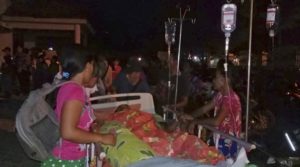
Earthquake of 7.5 magnitude rocked the Indonesian island of Sulawesi on Friday, triggering a 5-feet-tall tsunami which swept away houses in the cities of Palu and Donggala. The death toll rose to 384 on Saturday as the area suffered power outage leading to the grounding of communication networks.
Disaster agency spokesman Sutopo Purwo Nugroho said it rescue efforts on Friday were difficult after Sulawesi capital city Palu plunged into darkness and its communication lines were snapped. He said houses were swept away and several families were reported missing.
The airport in Palu city remained closed today. The US Geological Survey said the strongest quake had a magnitude of 7.5 and was centred at a depth of 6 miles (10 kilometres) about 35 miles (56 kilometres) northeast of the central Sulawesi town of Donggala. It briefly triggered a tsunami warning.
“When the (tsunami) threat arose yesterday, people were still doing their activities on the beach and did not immediately run and they became victims,” Sutopo Purwo Nugroho, spokesman of Indonesia’s disaster mitigation agency BNPB said in news briefing in Jakarta. “The tsunami didn’t come by itself, it dragged cars, logs, houses, it hit everything on land,” Nugroho said.
Nugroho described the damage as “extensive” with thousands of houses, hospitals, shopping malls and hotels collapsed, a bridge washed away and the main highway to Palu cut off due to a landslide. Bodies of some victims were found trapped under the rubble of collapsed buildings, he said, adding 540 people were injured and 29 missing. Dozens of injured people were being treated in makeshift medical tents set up outdoors, TV images showed.
More than 600,000 people live in Donggala and Palu. Chief security minister Wiranto told TVOne the military had started sending in cargo planes from the capital Jakarta carrying relief aid. The city’s airport is slated to reopen on Saturday afternoon after being closed as its runway and air traffic control tower was damaged in the quake, authorities said. President Joko Widodo is scheduled to visit evacuation centres in Palu on Sunday.
On August 5, a powerful quake on the island of Lombok killed 505 people, most of whom died in collapsing buildings. Another series of strong quakes in mid-August killed at least a dozen on Lombok and neighbouring Sumbawa island. In December 2004, a massive magnitude 9.1 earthquake off Sumatra in western Indonesia triggered a tsunami that killed 230,000 people in a dozen countries.
Indonesia’s meteorological and geophysics agency BMKG issued a tsunami warning after the quake, but lifted it 34 minutes later. The agency has been widely criticised for not informing a tsunami had hit Palu on Saturday, though officials said waves had come within the time the warning was issued.
At least 48 people had been killed and the death toll was expected to rise, said Nugroho. Hundreds of people who were preparing for a beach festival to celebrate Palu’s anniversary were unaccounted for, he said. The festival was due to start Friday night. Amateur footage shown by local TV stations, which could not immediately be authenticated by Reuters, showed waters crashing into houses along Palu’s shoreline, scattering shipping containers and flooding into a mosque in the city. Nugroho described the damage as “extensive” with thousands of houses, hospitals, shopping malls and hotels collapsed and a bridge washed away. Bodies of victims trapped between the rubble of collapsing buildings were also found, he said, adding that more than 350 people were injured.
Chief security minister Wiranto told TVOne the military had started sending in cargo planes from the capital Jakarta carrying relief aid. The city’s airport remained closed after its runway and air traffic control tower was damaged in the quake but officials said they were preparing to reopen to allow aid to come in. “We hope the airport can be reopened soon for flights carrying disaster relief and aid,” said Yohannes Sirait of AirNav, the air traffic management agency.
In Palu, the capital of Central Sulawesi province, a large bridge spanning a coastal river had collapsed and the city was strewn with debris. The city is built around a narrow bay that apparently magnified the force of the tsunami waters as they raced into the tight inlet. An AP reporter saw bodies partially covered by tarpaulins and a man carrying a dead child through the wreckage. Indonesian TV showed a smartphone video of a powerful wave hitting Palu, with people screaming and running in fear. The water smashed into buildings and a large mosque already damaged by the earthquake.
U.N. spokesman Stephane Dujarric said U.N. officials were in contact with Indonesian authorities and “stand ready to provide support as required.”
At least 30 people were killed in the bay city of Palu in Indonesia’s Sulawesi island, a hospital official told Metro TV on Saturday, after the area was hit by strong earthquakes and a tsunami a day earlier. Authorities were having difficulties coordinating rescue efforts as the 7.5 magnitude quake caused a power outage that cut communications around Palu and the nearby fishing town of Donggala, the closest to the epicentre of the quake 27 km (17 miles) away.
“The cut to telecommunications and darkness are hampering efforts to obtain information,” Disaster agency spokesman Sutopo Purwo Nugroho said, as reported by AP. “All national potential will be deployed, and tomorrow morning we will deploy Hercules and helicopters to provide assistance in tsunami-affected areas,” he added.




